

Easy & Affordable Backyard Aquaponics. How To Build Your Own Aquaponics System. A begginer's Guide to building a Home Aquaponic System on a Low Budget HD. Introduction to Home Aquaponics. Murray Hallams Practical Aquaponics. Raising BackYard Chickens, Build a Chicken Coop, Pictures of Breeds. Jackie’s tips for hardcore homesteading by Jackie Clay. Many of us have a garden and enjoy fresh vegetables during the summer and fall.

Maybe we even have a few chickens for eggs and meat. But many of us may want to extend our homesteading to what I call "hard-core" homesteading. This is serious homesteading, aimed at being able to provide your family with nearly all of its basic needs. Luckily, most of us with a piece of out-of-the-way land can become nearly "store-bought-free," raising much of what we need in nearly the same way as did our ancestors. Max and Carol's System - Backyard Aquaponics. Max and Carol had a simple request, they had almost finished building their greenhouse and they wanted as many beds as they could fit within the area for maximum production.

The plan was worked out before hand using 3D sketchup models. Two bed entertainer systems were going to fit beautifully within the area of their greenhouse and with the 1000L tanks under opposite beds there was more than enough room to get around the systems to access everything. Max and Carol lived a few hours away from town and because there were so many systems going in, the install team needed two vehicles, and they were going to be away over night. Max had done an amazing job of preparing the site before hand. David's System - Backyard Aquaponics. David wanted a site consultation before his system was installed.
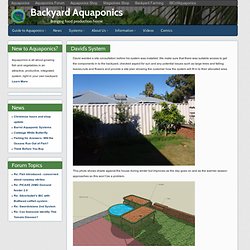
We make sure that there was suitable access to get the components in to the backyard, checked aspect for sun and any potential issues such as large trees and falling leaves,nuts and flowers and provide a site plan showing the customer how the system will fit in to their allocated area. This photo shows shade against the house during winter but improves as the day goes on and as the warmer season approaches so this won’t be a problem.
After the initial consultation a design was drawn up for the system, it would be an entertainer with an upgraded tank, from 1000L to 1500L. Davis prepared the area before we came by removing the turf and laying down some clean sand over the area. Great care is taken to ensure the beds are level and lined up correctly, as the sand was a bit soft under the legs, bricks were used to ensure no subsidence. The system is almost finished. All finished. Get to know Aquaponics - Backyard Aquaponics. What Is Aquaponics - Backyard Aquaponics. Aquaponics is essentially the combination of Aquaculture and Hydroponics.

Both aquaculture and hydroponics have some down sides, hydroponics requires expensive nutrients to feed the plants, and also requires periodic flushing of the systems which can lead to waste disposal issues. Re-circulating aquaculture needs to have excess nutrients removed from the system, normally this means that a percentage of the water is removed, generally on a daily basis. This nutrient rich water then needs to be disposed of and replaced with clean fresh water. While re-circulating aquaculture and hydroponics are both very efficient methods of producing fish and vegetables, when we look at combining the two, these negative aspects are turned into positives. The positive aspects of both aquaculture and hydroponics are retained and the negative aspects no longer exist. The plants extract the water and nutrients they need to grow, cleaning the water for the fish.
Aquaponics. System combining aquaculture with hydroponics in A symbiotic environment A small, portable aquaponics system.
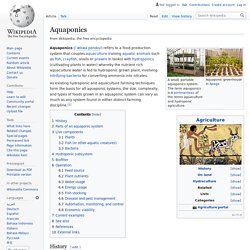
The term aquaponics is A portmanteau of the terms aquaculture and hydroponic agriculture. Aquaponic greenhouse in Apaga Aquaponics () refers to a food production system that couples aquaculture (raising aquatic animals such as fish, crayfish, snails or prawns in tanks) with hydroponics (cultivating plants in water) whereby the nutrient rich aquaculture water is fed to hydroponic grown plant, involving nitrifying bacteria for converting ammonia into nitrates. As existing hydroponic and aquaculture farming techniques form the basis for all aquaponic systems, the size, complexity, and types of foods grown in an aquaponic system can vary as much as any system found in either distinct farming discipline.[1] History[edit] Aquaponics has ancient roots, although there is some debate on its first occurrence: Aquaculture. Global harvest of aquatic organisms in million tonnes, 1950–2010, as reported by the FAO [1] Aquaculture, also known as aquafarming, is the farming of aquatic organisms such as fish, crustaceans, molluscs and aquatic plants.[2][3] Aquaculture involves cultivating freshwater and saltwater populations under controlled conditions, and can be contrasted with commercial fishing, which is the harvesting of wild fish.[4] Broadly speaking, finfish and shellfish fisheries can be conceptualized as akin to hunting and gathering while aquaculture is akin to agriculture.[5] Mariculture refers to aquaculture practiced in marine environments and in underwater habitats.

According to the FAO, aquaculture "is understood to mean the farming of aquatic organisms including fish, molluscs, crustaceans and aquatic plants. Farming implies some form of intervention in the rearing process to enhance production, such as regular stocking, feeding, protection from predators, etc. History[edit] Species groups[edit] National Aquaculture Association. Aquaculture. How to Start a Small Farm Business. How to Apply for Farm Grants. Government Grants to Start Up a Farm. At the federal level, many grants come from U.S.

Department of Agriculture (USDA) funds, though the grants may be administered by another agency, such as the National Institute for Food and Agriculture (NIFA). Federal Grants Wire lists grants for people looking to buy farmland, each of which serves a certain need for a specific niche. Grants from the Beginning Farmer and Rancher Development Program, for instance, aim to help younger farmers acquire farmland from retiring farmers. The Natural Resources Conservation Service (NRCS), as part of its Farmland Protection Program, provides a grant for farmers to buy farmland that contains prime or unique soils. The program aims to limit conversion of farmland to non-agricultural uses.
Grants for Buying Farm Land. How to Get A Government Grant For A Farm. Funding Opportunities. Key scientific, environmental, and socio-economic questions for marine aquaculture are being answered with the help of the NOAA National Marine Aquaculture Initiative competitive grants program.
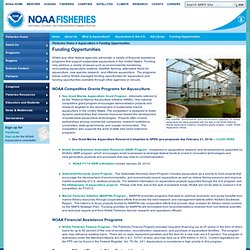
[credit: NOAA Aquaculture Office] NOAA and other federal agencies administer a variety of financial assistance programs that support sustainable aquaculture in the United States. Funding may address a variety of issues such as environmental monitoring, recirculating aquaculture systems, shellfish farming, alternative feeds for aquaculture, new species research, and offshore aquaculture. The programs below outline NOAA-managed funding opportunities for aquaculture and funding opportunities available through other agencies or venues. NOAA Competitive Grants Programs for Aquaculture NOAA Financial Assistance Programs Programs Offered Through Other Federal Agencies For information about all federal funding opportunities.
Resources — Hawaii Department of Agriculture. Aquaponic Farming When Will the First Plants Be Ready - Build Your Own Aquaponics. Starting an aquaponic garden can be quite an easy task, especially for those who have already tried the hydroponic system.
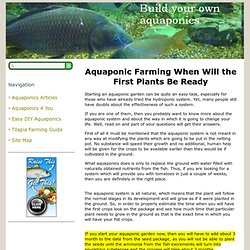
Yet, many people still have doubts about the effectiveness of such a system. If you are one of them, then you probably want to know more about the aquaponic system and about the way in which it is going to change your life. 5 Things You Should Take Into Consideration When Building an Aquaponic System - Build Your Own Aquaponics. Setting up an aquaponic system, although quite an easy task, requires some basic knowledge of aquaponics.
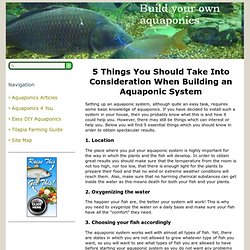
If you have decided to install such a system in your house, then you probably know what this is and how it could help you. However, there may still be things which can interest or help you. Below you will find 5 essential things which you should know in order to obtain spectacular results. 1. Location The place where you put your aquaponic system is highly important for the way in which the plants and the fish will develop. 2. Untitled. Harris Seeds partners with many of the country’s leading plug & liner grower specialists to provide you with the best quality young plants. Plugs and liners are grown to order, and you can choose from thousands of varieties of annuals and perennials for bedding plant, container and cut flower sales.
A number of different tray and cell sizes will allow you to choose the item and stage of maturity that best suits your growing practices and your market. Order from Harris Seeds, and your trays will be shipped directly from the supplier to you. Build a vertical aquaponic veggie & fish farm for small yards & houses. This low-cost vertical aquaponic system can grow leafy greens, herbs and raise fish for a small family year round, and it fits in a 5' by 3' space.
Sean Brady, the aquaponics projects coordinator at the Center for Sustainable Aquaponics and Nourish the Planet in Loveland, Colo., showed us how to build a system from scrap he found around the greenhouse. We published a version of this how-to guide at engineeringforchange.org, and it's one of the good ones, so we'd like to share it with Instructables, too.
What it is A vertical aquaponic system grows vegetables without soil in columns above a fish tank. By growing vertically, you can produce about twice the amount of plants as you can with a hydroponic system of the same area. One five-foot tower can produce more than 200 heads of lettuce per year. The system puts fish waste to work as fertilizer for crops. You do have to replace lost water as needed, power the pump and feed the fish. Build time About two hours.